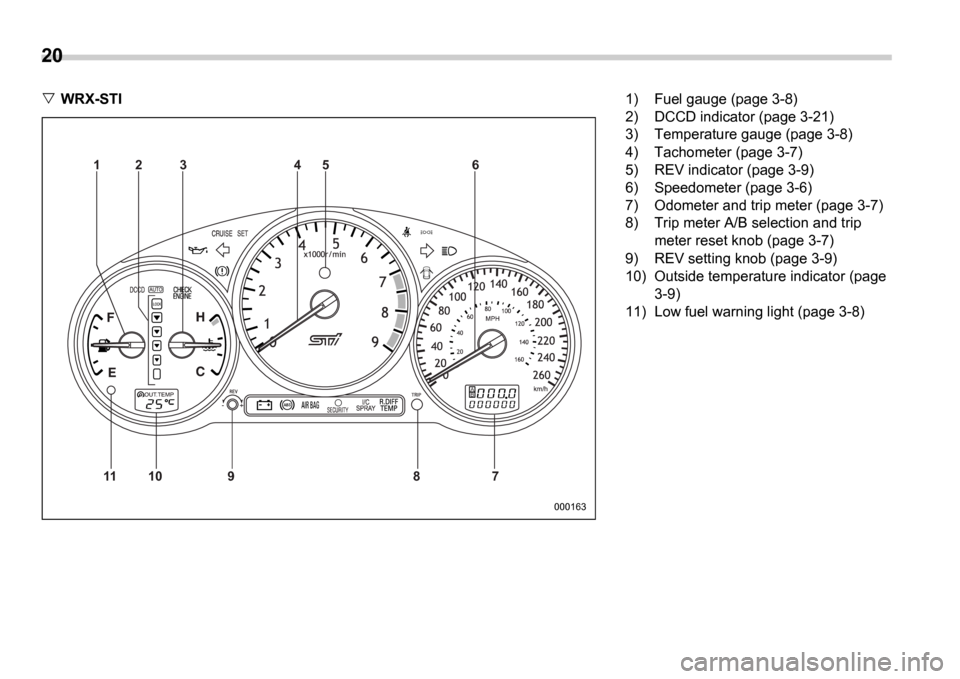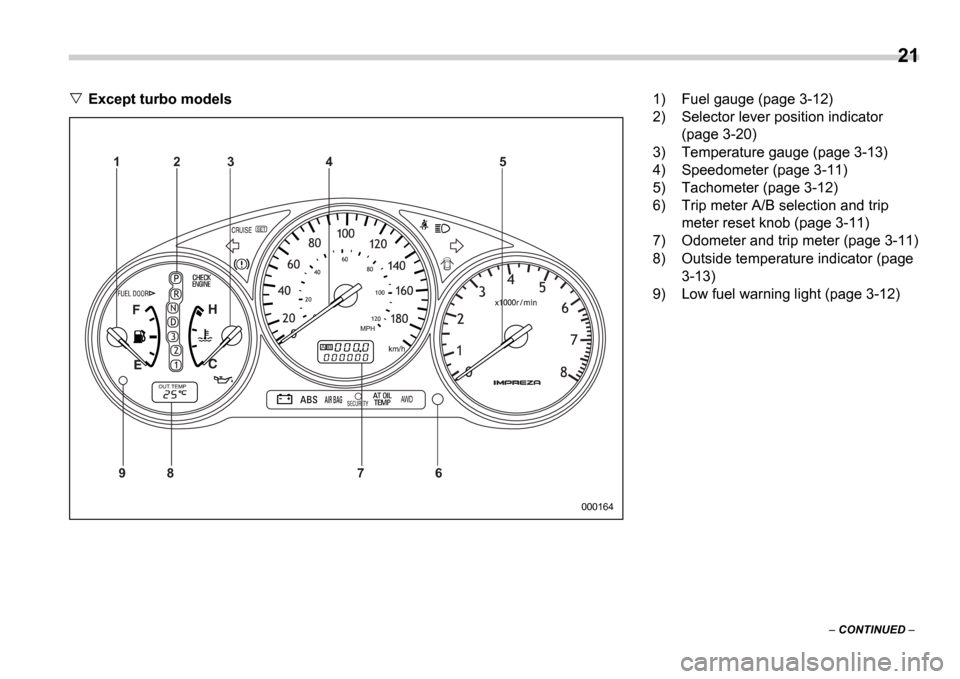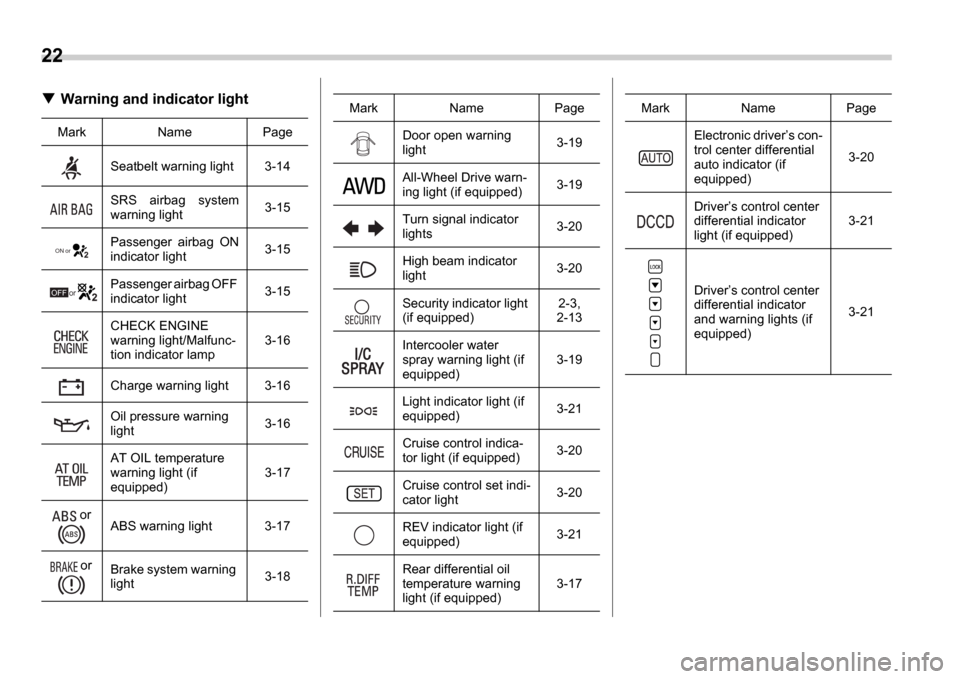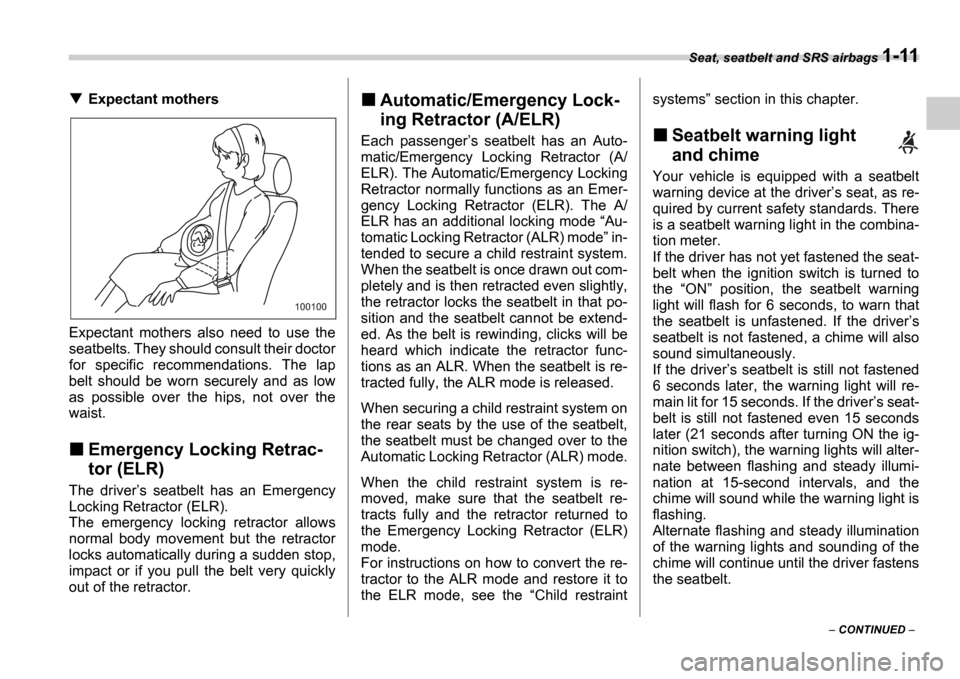2006 SUBARU IMPREZA warning
[x] Cancel search: warningPage 23 of 365

20
WRX-STI
000163
AB
11 10 9 8 76
5
4
3
2
1
1) Fuel gauge (page 3-8)
2) DCCD indicator (page 3-21)
3) Temperature gauge (page 3-8)
4) Tachometer (page 3-7)
5) REV indicator (page 3-9)
6) Speedometer (page 3-6)
7) Odometer and trip meter (page 3-7)
8) Trip meter A/B selection and trip
meter reset knob (page 3-7)
9) REV setting knob (page 3-9)
10) Outside temperature indicator (page 3-9)
11) Low fuel warning light (page 3-8)
Page 24 of 365

21
CONTINUED
Except turbo models
AB
9 8 7 6 5
4
3
2
1
000164
1) Fuel gauge (page 3-12)
2) Selector lever position indicator
(page 3-20)
3) Temperature gauge (page 3-13)
4) Speedometer (page 3-11)
5) Tachometer (page 3-12)
6) Trip meter A/B selection and trip meter reset knob (page 3-11)
7) Odometer and trip meter (page 3-11)
8) Outside temperature indicator (page 3-13)
9) Low fuel warning light (page 3-12)
Page 25 of 365

22
Warning and indicator light
Mark Name PageSeatbelt warning light 3-14
SRS airbag system
warning light 3-15
Passenger airbag ON
indicator light 3-15
Passenger airbag OFF
indicator light 3-15
CHECK ENGINE
warning light/Malfunc-
tion indicator lamp 3-16
Charge warning light 3-16
Oil pressure warning
light 3-16
AT OIL temperature
warning light (if
equipped) 3-17
or ABS warning light 3-17
or Brake system warning
light 3-18
ON or
OFF or
Door open warning
light
3-19
All-Wheel Drive warn-
ing light (if equipped) 3-19
Turn signal indicator
lights 3-20
High beam indicator
light 3-20
Security indicator light
(if equipped) 2-3,
2-13
Intercooler water
spray warning light (if
equipped) 3-19
Light indicator light (if
equipped) 3-21
Cruise control indica-
tor light (if equipped) 3-20
Cruise control set indi-
cator light 3-20
REV indicator light (if
equipped) 3-21
Rear differential oil
temperature warning
light (if equipped) 3-17
Mark Name PageElectronic driver
s con-
trol center differential
auto indicator (if
equipped) 3-20
Driver s control center
differential indicator
light (if equipped) 3-21
Driver s control center
differential indicator
and warning lights (if
equipped) 3-21
Mark Name Page
Page 28 of 365

1
Seat, seatbelt and SRS airbags
Front seats .......................................................... 1-2
Fore and aft adjustment ........................... .............. 1-3
Reclining the seatback ............................ ............... 1-3
Seat cushion height adjustment (driver s seat) ... 1-4
Head restraint adjustment (if equipped) ........... .... 1-4
Active head restraint (if equipped) ............... ......... 1-4
Seat heater (if equipped) ......................... .......... 1-5
Rear seats ........................................ ................... 1-6
Armrest (if equipped) ............................. ................ 1-7
Head restraint adjustment Wagon ..................... 1-7
Folding down the rear seat Wagon .................... 1-8
Seatbelts ......................................... .................... 1-9
Seatbelt safety tips .............................. ................... 1-9
Emergency Locking Retractor (ELR) ................. ... 1-11
Automatic/Emergency Locking Retractor
(A/ELR) ........................................... ....................... 1-11
Seatbelt warning light and chime .................. ........ 1-11
Fastening the seatbelt ............................ ................ 1-12
Seatbelt maintenance .............................. ............... 1-18
Seatbelt extender ................................. .............. 1-19
Front seatbelt pretensioners ...................... ....... 1-20
System monitors ................................... ................. 1-21
System servicing .................................. .................. 1-22
Precautions against vehicle modification .......... .. 1-22
Child restraint systems ........................... .......... 1-23
Where to place a child restraint system ........... .... 1-24
Choosing a child restraint system ................. ....... 1-25
Installing child restraint systems with A/ELR seatbelt .......................................... ........................ 1-26Installing a booster seat .........................
................ 1-29
Installation of child restraint systems by use of lower and tether anchorages (LATCH) ............... 1-30
Top tether anchorages ............................. .............. 1-33
*SRS airbag (Supplemental Restraint System airbag) ........................................... ................... 1-35
Vehicle with driver s and front passenger s SRS
airbags and lap/shoulder restraints ............... .... 1-35
Subaru advanced frontal airbag system ............. . 1-39
SRS side airbag ................................... ................... 1-51
SRS airbag system monitors ........................ ......... 1-56
SRS airbag system servicing ....................... ......... 1-57
Precautions against vehicle modification .......... .. 1-58
Page 38 of 365

Seat, seatbelt and SRS airbags 1-11
CONTINUED
Expectant mothers
Expectant mothers also need to use the
seatbelts. They should consult their doctor
for specific recommendations. The lap
belt should be worn securely and as low
as possible over the hips, not over the
waist.
Emergency Locking Retrac-
tor (ELR)
The driver s seatbelt has an Emergency
Locking Retractor (ELR).
The emergency locking retractor allows
normal body movement but the retractor
locks automatically during a sudden stop,
impact or if you pull the belt very quickly
out of the retractor.
Automatic/Emergency Lock-
ing Retractor (A/ELR)
Each passenger s seatbelt has an Auto-
matic/Emergency Locking Retractor (A/
ELR). The Automatic/Emergency Locking
Retractor normally functions as an Emer-
gency Locking Retractor (ELR). The A/
ELR has an additional locking mode Au-
tomatic Locking Retractor (ALR) mode in-
tended to secure a child restraint system.
When the seatbelt is once drawn out com-
pletely and is then retracted even slightly,
the retractor locks the seatbelt in that po-
sition and the seatbelt cannot be extend-
ed. As the belt is rewinding, clicks will be
heard which indicate the retractor func-
tions as an ALR. When the seatbelt is re-
tracted fully, the ALR mode is released.
When securing a child restraint system on
the rear seats by the use of the seatbelt,
the seatbelt must be changed over to the
Automatic Locking Retractor (ALR) mode.
When the child restraint system is re-
moved, make sure that the seatbelt re-
tracts fully and the retractor returned to
the Emergency Locking Retractor (ELR)
mode.
For instructions on how to convert the re-
tractor to the ALR mode and restore it to
the ELR mode, see the Child restraint systems
section in this chapter.Seatbelt warning light
and chime
Your vehicle is equipped with a seatbelt
warning device at the driver s seat, as re-
quired by current safety standards. There
is a seatbelt warning light in the combina-
tion meter.
If the driver has not yet fastened the seat-
belt when the ignition switch is turned to
the ON position, the seatbelt warning
light will flash for 6 seconds, to warn that
the seatbelt is unfastened. If the driver s
seatbelt is not fastened, a chime will also
sound simultaneously.
If the driver s seatbelt is still not fastened
6 seconds later, the warning light will re-
main lit for 15 seconds. If the driver s seat-
belt is still not fastened even 15 seconds
later (21 seconds after turning ON the ig-
nition switch), the warning lights will alter-
nate between flashing and steady illumi-
nation at 15-second intervals, and the
chime will sound while the warning light is
flashing.
Alternate flashing and steady illumination
of the warning lights and sounding of the
chime will continue until the driver fastens
the seatbelt.
100100
Page 39 of 365

1-12 Seat, seatbelt and SRS airbags
NOTE
If the driver unfastens the seatbelt af-
ter fastening, the seatbelt warning de-
vice operates as follows according to
the vehicle speed.
At speeds lower than approximate-
ly 9 mph (15 km/h)
The warning light will alternate be-
tween flashing and steady illumina-
tion at 15-second intervals. The
chime will not sound.
At speeds higher than approxi-
mately 9 mph (15 km/h)
The warning light will alternate be-
tween flashing and steady illumina-
tion at 15-second intervals and the
chime will sound while the warning
light is flashing.
It is possible to cancel the warning
operation that follows the 6-second
warning after turning ON the ignition
switch by unfastening and refastening
the driver s seatbelt. When the ignition
switch is turned ON next time, howev-
er, the complete sequence of the warn-
ing operation resumes. For further de-
tails about canceling the warning oper-
ation, please contact your SUBARU
dealer.
Fastening the seatbelt
Never use a belt that is twisted or
reversed. In an accident, this can
increase the risk or severity of in-
jury.
Keep the lap belt as low as possi-
ble on your hips. In a collision,
this spreads the force of the lap
belt over stronger hip bones in-
stead of across the weaker abdo-
men.
Seatbelts provide maximum re-
straint when the occupant sits
well back and upright in the seat.
To reduce the risk of sliding under
the seatbelt in a collision, the
front seatbacks should be always
used in the upright position while
the vehicle is running. If the front
seatbacks are not used in the up-
right position in a collision, the
risk of sliding under the lap belt
and of the lap belt sliding up over
the abdomen will increase, and
both can result in serious internal
injury or death.
Do not put cushions or any other
materials between occupants and
seatbacks or seat cushions. If you
do so, the risk of sliding under the
lap belt and of the lap belt sliding
up over the abdomen will in-
crease, and both can result in se-
rious internal injury or death.
Never place the shoulder belt under
the arm or behind the back. If an ac-
cident occurs, this can increase the
risk or severity of injury.
100101
Page 46 of 365

Seat, seatbelt and SRS airbags 1-19
Seatbelt extender
If the front seatbelts are not long enough
to permit the tongue plate to engage with
the seatbelt buckle, an optional seatbelt
extender is available from your SUBARU
dealer. When ordering an extender, only
order one particularly designed for your
vehicle. Several different types of extend-
ers are available to match various variet-
ies of front seatbelt designs. See your
SUBARU dealer for assistance.
The extender adds approximately 8 inch-
es (200 mm) of length and it can be used
for either the driver or front passenger
seating position.
For the safety of others, the extender
should be removed after each use, espe-
cially if the next person using the seatbelt
does not need one.
Note that leaving the seatbelt extender s
tongue plate engaged with the seatbelt
buckle may prevent the Subaru advanced
front airbag system from functioning cor-
rectly or cause the system to fail.
NOTE
When the seatbelt extender is used by a pregnant passenger, consult a doctor
to get approval in advance.
To connect the extender to the seatbelt,
insert the tongue plate into the seatbelt
buckle so that the
PRESS signs on the
buckle-release buttons of the extender
and the seatbelt are both facing outward
as shown in the diagram. You will hear a
click when the tongue plate locks into the
buckle.
When releasing the seatbelt, press on the
buckle-release button on the extender, not
on the seatbelt. This helps to prevent
damage to the vehicle interior and extend-
er itself.
Be sure to observe the following
when using the seatbelt extender.
Failure to follow these instructions
and warnings could reduce the ef-
fectiveness of the seatbelt and re-
sult in more serious injury in the
event of a collision.
Never use the extender when the
belt itself is long enough to permit
it to be buckled properly. If remov-
al of heavy clothing is all that is
needed to permit the seatbelt to
be buckled properly, remove the
heavy clothing and do not use the
extender.
Do not use the extender if the
buckle of the extender rests over
the abdomen.
Do not let someone else use the
extender. Use of an extender
when it is not needed could re-
duce the effectiveness of the seat-
belt and result in more serious in-
jury in the event of a collision.
Use the extender only for the front
seatbelts and only for the model
for which it was originally provid-
ed. Never use the extender for the
rear seatbelts or for a different
model.
100605
Page 48 of 365

Seat, seatbelt and SRS airbags 1-21
CONTINUED
System monitors
A diagnostic system continually monitors
the readiness of the seatbelt pretensioner
while the vehicle is being driven. The seat-
belt pretensioners share the control mod-
ule with the SRS airbag system. There-
fore, if any malfunction occurs in a seat-
belt pretensioner, the SRS airbag system
warning light will illuminate. The SRS air-
bag system warning light will show normal
system operation by lighting for approxi-
mately 6 seconds when the ignition switch is turned to the
ON position.
The following components are monitored
by the indicator:
Front sub sensor (Right-hand side)
Front sub sensor (Left-hand side)
Airbag control module (including impact
sensors)
Frontal airbag module (Driver s side)
Frontal airbag module (Front passen-
ger s side)
Side airbag sensor (Center pillar right
hand side)
Side airbag sensor (Center pillar left
hand side)
Side airbag module (Driver s side)
Side airbag module (Front passenger s
side)
Seatbelt pretensioner (Driver s side)
Seatbelt pretensioner (Front passen-
ger s side)
Seatbelt buckle switch (Driver s side)
Seatbelt buckle switch (Front passen-
ger s side)
Driver s seat position sensor
Front passenger s seatbelt tension sen-
sor
Front passenger s occupant detection
system weight sensor
Front passenger s occupant detection
control module
Front passenger s frontal airbag ON
and OFF indicator
All related wiringWhen discarding front seatbelt re-
tractor assemblies or scrapping
the entire vehicle due to collision
damage or for other reasons, con-
sult your SUBARU dealer.
100291
If the warning light exhibits any of
the following conditions, there may
be a malfunction in the seatbelt pre-
tensioners and/or SRS airbag sys-
tem. Immediately take your vehicle
to your nearest SUBARU dealer to
have the system checked. Unless
checked and properly repaired, the
seatbelt pretensioners and/or SRS
airbag will not operate properly in
the event of a collision, which may
increase the risk of injury.
Flashing or flickering of the indi-
cator light
No illumination of the warning
light when the ignition switch is
first turned to the ON position
Continuous illumination of the
warning light
Illumination of the warning light
while driving